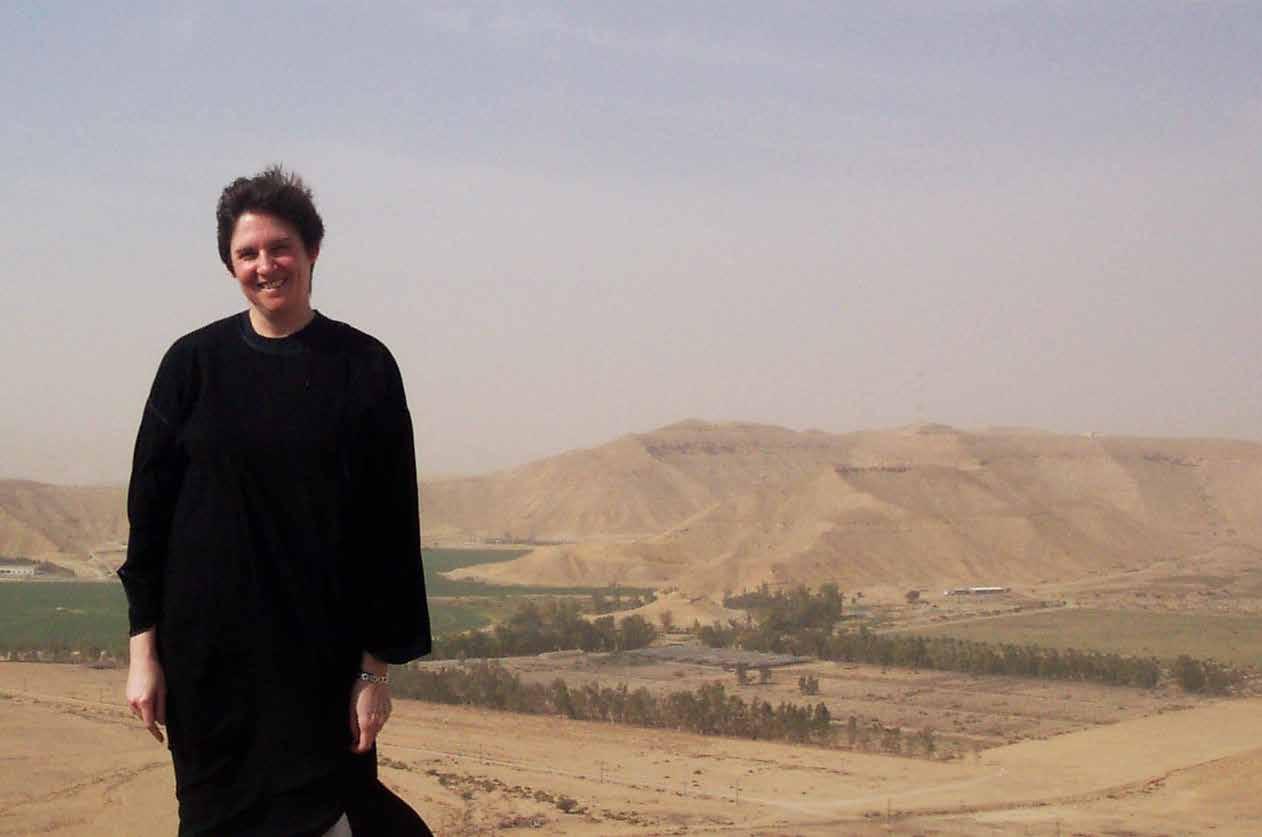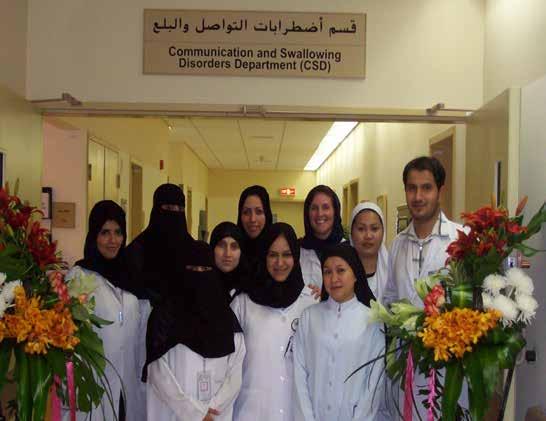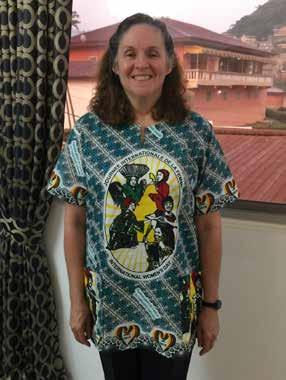
10 minute read
Workplace Always an Audiologist. Dawn Doig, Aud(C
Always an Audiologist
A peripatetic audiologist travels to remote regions of the world, providing hearing tests and treatments to underserved populations— and penning a children’s book, too. By Dawn Doig, Aud(C)
Advertisement
Dawn Doig in the mid-2000s in Saudi Arabia, one of several countries she’s lived in and practiced audiology.
My father was born in Canada. An orphan, he spent time in a foster home as a child. When I was growing up, my family got to know his foster family very well, and even called his foster mother Grandma. In this family there were two grandchildren who were deaf, who married spouses who were also deaf, but they all had typical hearing children. I watched in fascination as the young hearing children who could barely speak signed with their parents. I had no idea what audiology was at the time, and little did I know that the seed had been planted for my future career.
After earning a master’s in audiology (and my husband Bruce earned a dual degree in art history and education), we moved to Peace River, Alberta, with our 2-year-old daughter. For the next four years, I was the sole audiologist for 40,000 people. This was one of the greatest periods of growth for me as an audiologist, and I carried with me around the globe the invaluable experience I gained during this time.
As a young clinician I needed to hone my audiology skills even though there was no one
nearby to assist me. An introvert by nature, I had to become an advocate for my patients as well as the audiology program. One critical thing I learned was the importance of thoroughly understanding your testing equipment—how to troubleshoot and knowing when it may be malfunctioning. For instance, I noticed power surges to the clinic affected the equipment, and it was unnerving wondering if subsequent hearing tests might be inaccurate.
Rural Canada was also the first place I realized that a population could be largely unaware of the issues surrounding hearing loss. Many of the patients I saw were older men who were lifelong farmers with noiseinduced hearing loss from farming practices and hunting. But a teenage boy I tested had the hearing loss of a much older patient and admitted he blasted his stereo in his car. When I pointed out the danger of losing his hearing permanently, he said he’d just get a louder boombox.
At this time, the audiology field did not have the ability to test otoacoustic emissions or
Early in my career I realized that a population could be largely unaware of the issues surrounding hearing loss. Many of the patients I saw were older men who had noise-induced hearing loss from their work using noisy equipment and from recreational noise exposure. But a teenage boy I tested had the hearing loss of a much older patient and admitted he blasted his stereo in his car. When I pointed out the danger of losing his hearing permanently, he said he’d just get a louder boombox.
frequency-specific auditory brainstem responses. Our hearing aids were analog, and the average age of diagnosis was between 2 and 3 years of age, well past the critical period for speech and language development.
Heading Abroad With cutbacks and a second child to raise, we headed to Abbotsford, British Columbia, near Vancouver, where I joined a private clinic. We bought a home and were beginning to put down roots, but in the summer of 1997 I went on a humanitarian trip to a school for the deaf in Lái Thiêu, Vietnam. This was my first time out of Canada, and it was unforgettable.
At the school near Ho Chi Minh City we met three girls who sang to us in Vietnamese. They were deaf, but one of the sisters, who was trained to do speech-language therapy, had taught them to sing. A man who made earmolds so we could replace body-worn hearing aids with those at ear level was skilled beyond comprehension, especially given the limited resources available to him, and the patients’ needs. One father traveled 125 miles with his teenage daughter, whose smile lit up the room after she was fitted with new ear-level aids. The career of Bob Carkner and his work bringing Canadian high school students to Guatemala and Vietnam was captured in a documentary, “A Man Named Bob.” When it aired on cable I made my TV debut.
This life-transforming experience abroad inspired me to apply to be an audiologist in Kuwait as part of a collaboration between Dalhousie University in Canada and the Kuwait Ministry of Health. In January 1998, I boarded a plane with my two young children and headed to Kuwait. My husband, finishing up his teaching contract, followed six months later. Kuwait was still extremely segregated with respect to the sexes, and coping with roadblocks—both real (road accidents), and figurative (regulations)—was challenging. But we also discovered the foods shawarma and fatayar and the spice zaatar in Kuwait and love them all to this day. We learned the word yella (“hurry”) and still use it!
It was in Kuwait that I wrote my children’s book “And So, Ahmed Hears.” By this time, I’d had the pleasure of working with so many special children coping daily with hearing loss. The book was illustrated by my daughter, then 6, complete with a veiled mother. The character Ahmed is a conglomeration of children I’d met and worked with, and I wanted to help improve public awareness of pediatric hearing loss and the need for early diagnosis and intervention.
Remote Populations When my family and I returned to Canada two years later, we settled in the far north where my experience working with non-English-speaking patients had prepared me for traveling with ENT doctors to remote Inuit villages above the treeline. I was the only audiologist for the vast area of the Northwest Territories, so I traveled frequently to small communities of 250 people or towns of a few thousand. Often it made more sense for us to fly and do clinic visits ranging from two to five 13- hour days. Within the community, we traveled by van and quad (all-terrain vehicle). Anyone needing surgery in the remote villages had to be flown to

Yellowknife, the capital of the Northwest Territories. The winter lasted eight months a year with temperatures descending to minus 58 degrees F. I once slept in my clothes, parka, gloves, and boots, plus blankets, because the heat wasn’t working in the hotel. We visited an igloo once on Pelly Bay, in far eastern Canada, and found it incredibly warm inside. We just sat quietly and listened to the silence.
Soon enough, I got itchy feet again. Bruce and I were each granted a leave of absence from our jobs, and in the summer of 2003, we packed up, sold our house, and flew to England. There I joined the Medway Maritime Hospital in Gillingham, Kent. The high incidence of middle ear pathology in the U.K. allowed me to learn all I could about bone-anchored hearing aids—knowledge that would prove useful later. That said, one year in England burned a hole in our wallets and we returned to Yellowknife.
Back to the Middle East I received a call from Saudi Arabia a year later. A large rehabilitation hospital in Riyadh was looking for an experienced audiologist to help start an audiology unit. When I went home that night, Bruce and I discussed the possibility of Saudi Arabia with our children, then 11 and 14 years old, and in November 2005 I boarded another plane, eight months ahead of my family.
The initial two-year contract in Riyadh turned into eight of the most rewarding years of my career. I wrote policies and procedures; started programs (NICU follow-ups, infant hearing screenings, oncology, cochlear implants, student internships); ordered equipment; and trained junior staff. I was finally able to catch up to my children’s Arabic ability (developed in Kuwait), learning to speak, read, and write Arabic. But sadly the leadership changed toward the end of my eighth year, undoing most of our work. I am hopeful the clinicians who left to complete clinical doctorates and

who are gradually returning will be able to restore the clinic to its former status of delivering a high standard of audiology and speech-language pathology services. Over the years, I shared my book “And So, Ahmed Hears” with audiologist friends and asked if any of them knew of a company that might be interested in using it with their pediatric program. One happened to be working with Widex Canada, the hearing aid company, and she took the idea to the director. Widex published it as a humanitarian project (albeit with their own illustrations) to help increase public awareness about childhood hearing loss, and for several years it was available for free to families in Canada. In 2018 the book was republished by Pen It! Publications; it can be found on Amazon and through other online retailers.
Teaching, Plus Audiology As our time in Saudi Arabia was coming to an end, I decided to go back to school to earn a master’s degree in teaching English as a second language. Bruce had followed me as a teacher for 23 years and now I would follow him. In 2013 I joined him in Ulaanbaatar, the capital of Mongolia, where I completed my practicum at the school where he was teaching. While in Mongolia, I was informed by many that I was the only certified audiologist in the country. I managed to visit several hearing clinics and was saddened by the condition of most. One ENT doctor I met had taught herself how to do hearing assessments from a textbook. With her heart in the right place, she was trying to do whatever she could to help the patients. At the children’s hospital, I saw that the assessments were conducted with the child in a small glass room with babies screaming in the soundbooth right next to it.
Eventually in my third year in Mongolia I was able to start a hearing screening program at our school because there was some infrastructure in place that could help
The initial two-year contract in Riyadh turned into eight of the most rewarding years of my career. I wrote policies and procedures; started programs (NICU follow-ups, infant hearing screenings, oncology, cochlear implants, student internships); ordered equipment; and trained junior staff. I was finally able to catch up to my children’s Arabic ability (developed in Kuwait), learning to speak, read, and write Arabic.
sustain it. Our time in Mongolia is the reason why “And So, Ahmed Hears” was translated into Mongolian through the local Rotary Club.
I am writing this from Cameroon, where I work in a pre-K to grade 12 school in the capital Yaoundé, teaching English as a second, third, or even fourth or fifth language. Although I am not currently practicing audiology, it will always be a part of who I am, and as in Mongolia I have been told that I am the only certified audiologist in the country.
I visited a school for the deaf with our grade 3 classes and am trying to get help for the school to build a new facility. A friend in Canada donated a combined audiometer/tympanometer screener, but it has not been easy to implement the needed screenings and services. We just renewed for another two years in Cameroon so I will keep exploring options to help bring hearing tests and treatments to people throughout the country.
After growing up in remote Canada and the Middle East, our now-adult children have more or less settled in Canada while my husband and I have continued our peripatetic lifestyle. I have been truly blessed with two extremely fulfilling careers in communication that have enabled me to work with people around the world.
Dawn Doig, M.Sc., M.Ed, Aud(C), is a certified Canadian audiologist who practiced for 23 years. She now works as an English as an additional language teacher in Cameroon. Including “And So, Ahmed Hears,” Doig has written more than 10 children’s books plus a cookbook. For more, see doigda.wixsite.com/mysite-1. She also wrote the poem “Hair Cell Eulogy,” at hhf.org/blog.

Opposite page (from far left): Dawn Doig and her husband Bruce in Mongolia; and Doig (fourth from right) with her staff in Saudi Arabia.

This page (top): The cover of Doig’s children’s book, inspired by patients she has worked with; and Doig in Cameroon, where she now lives.
Share your story: Tell us your hearing loss journey at editor@hhf.org.









